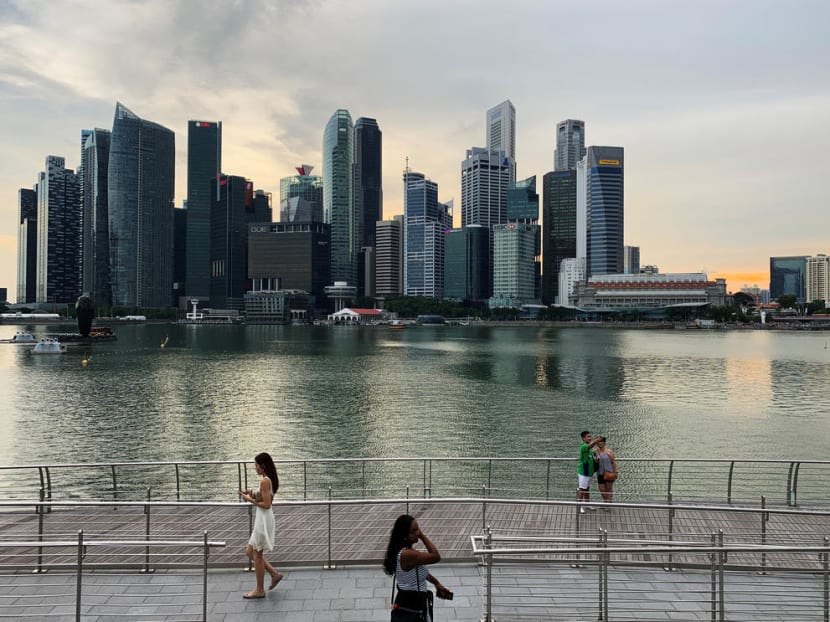Singapore's 2019 growth forecast slashed to 0.6%, trade tensions remain top risk: MAS survey
SINGAPORE — Private sector economists and analysts have lowered their forecast for Singapore’s economic growth in 2019, according to a survey report released by the Monetary Authority of Singapore (MAS) on Wednesday (Sep 4).

The economy is now expected to expand by 0.6 per cent this year, down from an earlier estimate of 2.1 per cent in June, with the escalation of trade tensions remaining the top risk cited by most survey respondents.
SINGAPORE — Private sector economists and analysts have lowered their forecast for Singapore’s economic growth in 2019, according to a survey report released by the Monetary Authority of Singapore (MAS) on Wednesday (Sep 4).
The economy is now expected to expand by 0.6 per cent this year, down from an earlier estimate of 2.1 per cent in June, with the escalation of trade tensions remaining the top risk cited by most survey respondents.
The revised forecast came after Singapore's economy grew by 0.1 per cent in the second quarter, lower than the 1.6 per cent projected by respondents in the previous survey.
Statistical projections also show the economy most likely growing by between 0.5 per cent and 0.9 per cent this year — lower than the findings from the previous survey of between 2.0 per cent and 2.4 per cent.
Last month, the Ministry of Trade and Industry downgraded its expected growth for 2019 to between 0 and 1 per cent, saying that the GDP is expected to come in “at around the mid-point of the forecast range”.
Median forecasts of key macroeconomic indicators also came in mostly lower in the quarterly survey.
Sharper declines are expected for manufacturing at 2.4 per cent, from the previous estimate of 0.2 per cent, as well as for wholesale and retail trade — now expected to fall by 2.8 per cent from the previous estimate of 0.3 per cent.
Slower growths are predicted in construction at 2.7 per cent, from the previous estimate of 3.5 per cent, and in accommodation and food services, which is expected to grow by 0.8 per cent from the previous estimate of 1.4 per cent.
Non-oil domestic exports is expected to slump 9.2 per cent in 2019, dropping from the predicted 2.1 per cent fall in the previous estimate.
Finance and insurance bucked the trend as its growth expectation was revised up to 4.3 per cent from 3.8 per cent previously.
Escalating trade tensions particularly between the US and China remains the top potential downside risk cited by 88.9 per cent of the 23 respondents, compared to 94.1 per cent in the previous survey from the last quarter.
China’s economic slowdown also remains second place in the list of top risks, mentioned by half of the economists surveyed.
Notably, there was a growing concern for geopolitical risks in places such as Hong Kong and the Persian Gulf, as 38.9 per cent of respondents cited it as a downside risk, up from the 5.9 per cent last June.
While the easing of trade tensions remained the top upside risk, many respondents believe that such a scenario is becoming less likely, with the proportion of respondents citing it as an upside risk falling to 61.1 per cent from 70.6 per cent.
More respondents (44.4 per cent) cited fiscal stimulus, both in Singapore and overseas, as an upside risk than before (17.6 per cent).
Another upside scenario mentioned by a third of respondents — up from 23.5 per cent — was easing financial conditions due to more lax monetary policy in developed markets.
Next year’s GDP growth expectation was also cut to 1.6 per cent from the 2.3 per cent previously, putting the estimate growth outcome in the range of 1.0 per cent to 1.9 per cent — down from the previously estimated 2.0 per cent to 2.4 per cent.
The survey report is based on responses from 23 economists and analysts, and does not represent MAS' views and forecasts. CNA
For more stories like this, visit cna.asia.






